
Selden Bowsprits - An elegant solution that really stands out
by Aleix Escorsell 18 Feb 2022 17:00 GMT
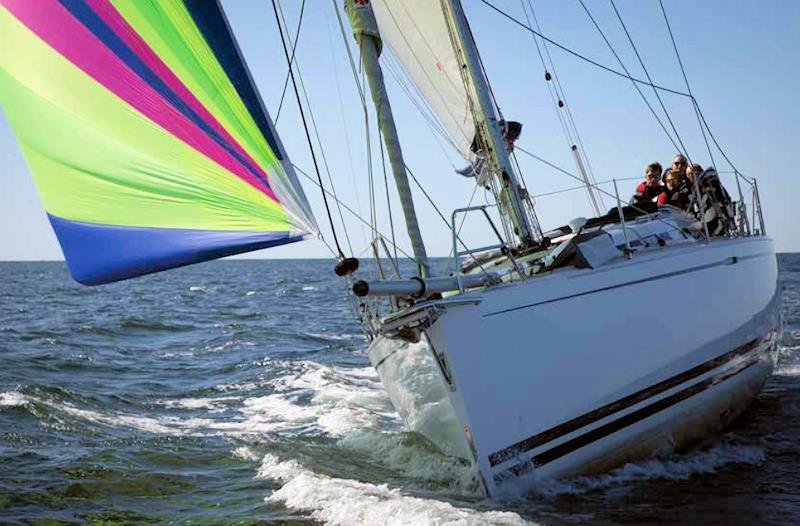
Selden extendable bowsprit © Selden Mast
Selden have been making sailing yacht masts since the 1960s and what started as a company that produced basic wooden masts has evolved into a world-leading brand with an extensive range of sail handling and deck hardware systems.
Some of their products have become household names in their own right (e.g. Furlex furlers) but in this article we take a closer look at their extremely popular, retrofit extendable bowsprits.
The Selden extendable bowsprit allows you to use an asymmetric spinnaker or code zero furler on a boat that doesn't have an attachment point forward of the forestay. While most modern performance cruising sailboats will have a permanent bowsprit, a lot of older boats will need a retrofit option. The benefits of a retractable system is that it is easy to install and doesn't increase your LOA, thus reducing your marina fees!
The bowsprit is attached to the foredeck using two structural fixing points. The forward / stem fitting, which Selden refer to as the "Bow bracket", has a stainless steel ring, with a low friction polyamide inner lining, which allows the bowsprit to extend and retract quickly and easily. The aft fitting is a standard folding padeye that clips onto the back end of the pole.
When in use, the bowsprit is held securely on the foredeck, between these two structural points, with the pole extending forward of the bow. When not in use, the back end of the pole can be unclipped from the padeye and moved aft to another "parking" padeye position so that the front of the pole remains in the stem ring. If the pole is not required for some time, it can easily be removed and stored below.
Fixing the aft end of the Selden bowsprit. One structural folding padeye for when the bowsprit is deployed, and a second further aft for storage.
There are a number of different, standard bow bracket configurations designed to accommodate a wide range of different bow layouts.
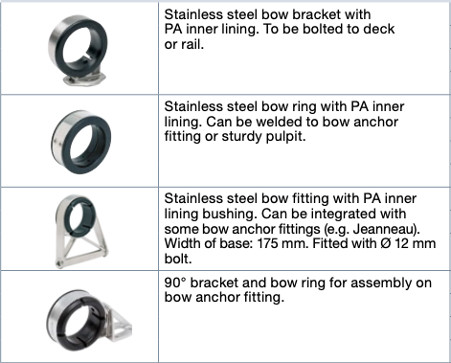
When buying a Selden retractable bowsprit you will buy the bowsprit (which includes the pole, an inboard and outboard end cast fitting, plus x2 folding padeyes) and then you need to also buy the correct bow bracket for your intended setup
When using a gennaker or code zero, you can rig up a tackline, either by running it through the centre of the bowsprit and back to the cockpit. Or, alternatively, you can fit an external block at the outboard end of the pole and run a separate tackline system.
What is RM30?
RM30 is the static Righting Moment the boat creates at 30 degrees heel. RM30 is a very standard reference point in yacht design because most of your sailing will be done within 30 degrees heel. For most hulls, the force to go from 0 to 30 degrees is also linear. Selden have developed a very useful RM30 calculator to help you figure out exactly what your RM30 is with just a few basic, commonly available boat details.
Specifying the correct size and length
The Selden Bowsprit has been designed to be suitable for a wide range of sailboats and comes in two materials, aluminium, or carbon.
In order to get the right bowsprit for your boat, you first need to determine the RM30 (Righting Moment at 30 degrees), to determine the correct tube diameter, and then deck space availability will determine the correct length.
Once you know your boat's RM30 you can use Selden's sizing guide tables. They have different tables for code zeros and asymmetrics, and for aluminium or carbon tubes.
Dimensioning for aluminium gennaker
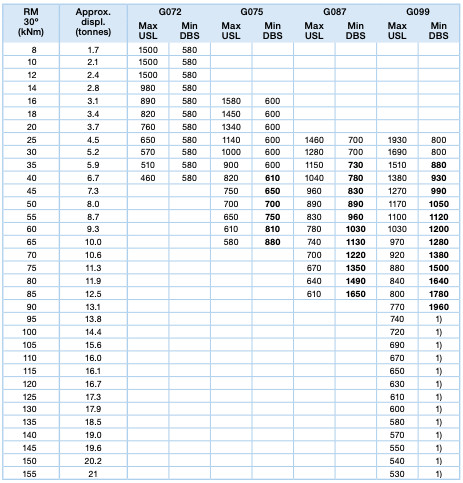
Max USL (unsupported Length) and Min DBS (Distance between Support) are dependent on RM30. So, once you know your RM30 you can see suitable tube diameters for your boat size and also the Maximum USL i.e. projected forward distance for your bowsprit. In the table above, with an RM30 of 25kNm you can use the GO72 (72mm diameter tube) with a Max USL of 650mm. However, if you need more forward projection to can use the GO75 up to a max USL of 1140mm forward of the bow bracket.
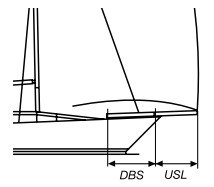
It is important to note when buying a bowsprit, to recognise that the loads on code zeros are significantly higher than asymmetric spinnakers/gennakers. Therefore, even if you are buying for a cruising gennaker it is important to consider whether in the future you might want to add a code zero to your sail wardrobe, as this will have an impact on the correct tube diameter and Max USL.
Dimensioning for aluminium code 0
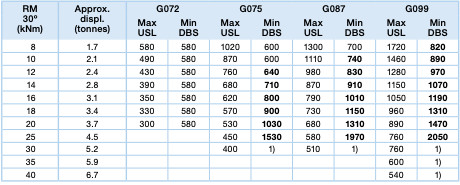
Continuing with our 25kNm RM30 example, for a code zero, the GO72 is no longer an option and Max USL has also dropped from 1140mm to 450mm on the GO75!
Bowsprit Length
Selden Bowsprits come as a standard length but can be cut down to suit your boat. The key question in determining the length of your bowsprit is the location of the structural padeye for the back end of the pole. This must be a solid, structural piece of the deck (not on a bow locker hatch!) that offers correct alignment to allow the pole to be deployed past any bow hardware. This point must be far enough back from the bow bracket to respect the Min DBS measurement for your boat.
Once you know your preferred DBS measurement, you then (generally) add the Max USL to give you your full bowsprit length. The only caveat is that you may not be able to achieve Max USL if your DBS is too large, in which case, you may want to consider going up a pole diameter.
Summary
On-deck retractable bowsprits are a simple, cost-effective retrofit solution to allow you to enjoy the performance benefits of flying code zeros and asymmetric spinnakers. Selden provides comprehensive guidance for owners to specify the correct tube diameter, determine the correct length, and have a variety of bow bracket options to suit a large range of bow configurations.
If you have any questions or would like to speak to us about fitting a bowsprit to your boat, please contact us at or find out more and see our range of bowsprits available.